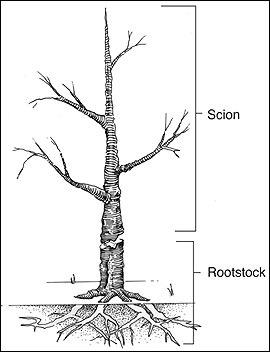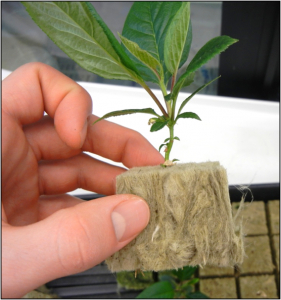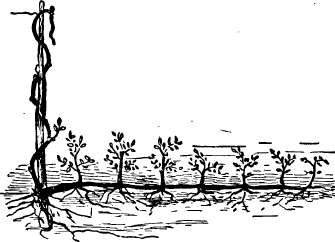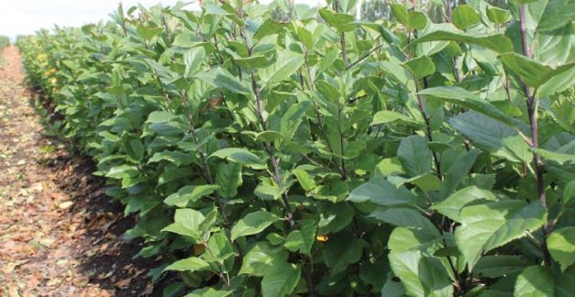
How to grow your own rootstocks
 When I summed up the purposes
of grafting, I
warned you that grafting won't create more plants, just change a
rootstock from one variety to another. So where do all those
rootstocks come from?
When I summed up the purposes
of grafting, I
warned you that grafting won't create more plants, just change a
rootstock from one variety to another. So where do all those
rootstocks come from?
If you want to grow your
own fruit tree rootstocks, you have two choices --- seeds or
cuttings. Seedling rootstocks are easy to grow --- just collect
pits from the fruit you eat and plant the seeds --- and seedlings have
the benefit that they're usually vigorous and healthy. With some
types of fruits, like peaches, a seedling roostock can be a good
choice, but most homesteaders with a small backyard won't want to grow
their apple rootstocks from seed since a standard apple tree can take
over their entire growing space. Instead, nurseries count on
carefully selected and vegetatively propagated rootstock varieties to
change the size of their trees and to confer resistance to disease.
 Vegetatively propagated
rootstocks are much more uniform than those
grown from seed, although you have to make an investment of space and
time to grow your own. You can either root cuttings (softwood or hardwood) or use layering (a method
of making one plant produce lots of shoots, which root and can be
severed to create new plants). Garner notes that cuttings can
usually be rooted for apples, pears, plums, and cherries, although my
own experience has shown that softwood cuttings need a lot of babying
and might not be worthwhile if you don't have the right
equipment.
Vegetatively propagated
rootstocks are much more uniform than those
grown from seed, although you have to make an investment of space and
time to grow your own. You can either root cuttings (softwood or hardwood) or use layering (a method
of making one plant produce lots of shoots, which root and can be
severed to create new plants). Garner notes that cuttings can
usually be rooted for apples, pears, plums, and cherries, although my
own experience has shown that softwood cuttings need a lot of babying
and might not be worthwhile if you don't have the right
equipment.
Stooling is a type of
layering that seems very easy for the beginner. You simply plant
a purchased rootstock, let it grow for a year, cut the tree to the
ground, then mound up dirt around the shoots to create new rootstocks
that can be removed later. The downside of stooling is that it
takes two years before you get your first harvest, but the stool can
produce for twenty or more years after that. If we like the
rootstock we use for our high
density apple experiment, I think it would be worth
starting a stool so that I could create our own dwarf apples in the
future.
 Some more complex types of
layering are used for various reasons. Etiolation (in which the
shoots arising from the rootstock are pegged down in a trench) is used
for shy rooters, like apples, pears, quince, plum, cherries, peaches,
walnuts, and mulberries. Etiolation is more work than stooling,
so should be considered only if you can't get your stock to root
otherwise. Similarly, air layering (in which a shoot is injured
and then surrounded with moist material to root above the soil line) is
a very sure technique, but doesn't produce as many offspring. At
the other extreme, tip layering is an easy way to get blackberries,
some raspberries, currants, and gooseberries to root.
Some more complex types of
layering are used for various reasons. Etiolation (in which the
shoots arising from the rootstock are pegged down in a trench) is used
for shy rooters, like apples, pears, quince, plum, cherries, peaches,
walnuts, and mulberries. Etiolation is more work than stooling,
so should be considered only if you can't get your stock to root
otherwise. Similarly, air layering (in which a shoot is injured
and then surrounded with moist material to root above the soil line) is
a very sure technique, but doesn't produce as many offspring. At
the other extreme, tip layering is an easy way to get blackberries,
some raspberries, currants, and gooseberries to root.
No matter how you start
our rootstocks, you need to grow the young plants until they're well
rooted before grafting onto them. Budding is often done the first
summer, but dormant grafting such as whip-and-tongue grafts have to
wait another year. So, if you planted a rootstock from the
nursery now, you could cut it to the ground to start a stool in fall
2013, mound up earth around the new shoots in 2014, cut loose your
rootstocks that winter, and graft onto them in early spring of 2016.
In case that seems
daunting, I should tell you that you can often order rootstocks
of named varieties from various nurseries. In addition, you
should check
with your local extension office since many run grafting workshops in
the spring which provide all of the rootstocks, scionwood, and
paraphernalia, allowing you to come home with several newly grafted
trees for a very small fee. A final option is to skip the rootstock entirely and graft a new branch onto an existing fruit tree in your yard.
I'd be very curious to
hear from anyone who has grown his or her own rootstock. Which
method did you use? Do you recommend it to others?
| This post is part of our Grafting lunchtime series.
Read all of the entries: |
Want more in-depth information? Browse through our books.
Or explore more posts by date or by subject.
About us: Anna Hess and Mark Hamilton spent over a decade living self-sufficiently in the mountains of Virginia before moving north to start over from scratch in the foothills of Ohio. They've experimented with permaculture, no-till gardening, trailersteading, home-based microbusinesses and much more, writing about their adventures in both blogs and books.
Want to be notified when new comments are posted on this page? Click on the RSS button after you add a comment to subscribe to the comment feed, or simply check the box beside "email replies to me" while writing your comment.



Thanks for the informative post! I enjoy Learning new stuff..so when the day comes I am ready to try some grafting, I've got a little background to start with. Enough to at least know where to look for more detailed instructions! You must read ALOT!
Thanks for the very interesting grafting post. I have germinated several apple seedlings, and was thinking of grafting on to them. The vigour of seedling rootstock appeals to me, considering my poorer soil. Everyone says the tree will get too large for a backyard. But just wondering - why can't the size of a tree be controlled, to any size, by constant pruning ? Especially if only a few trees need to be pruned, so labour is not a problem.
John --- Excellent question, and one I'll be experimenting with this coming year with our high density apple planting. The short answer is that if you just prune to keep a tree small, it will respond by sending up lots of vegetative growth and setting back its fruiting.
However, it clearly can be done --- for example, the San Francisco forest garden we visited this summer had a miniature planting based on full-size rootstocks. And one of our readers does the same. I'll be figuring out the tricks and posting about them this year.
Thanks Anna, much appreciated. I will be most interested in the results of your apple tree experiments. John
Anna,
The M9 series of dwarf rootstock are prone to suckering (lots of new shoots popping up from the roots around the base of the tree). While this is generally a nuisance, it is also a boon for us grafters. Dig down around the roots of your suckered tree (one side only, to prevent too much root damage from stunting the existing tree) and cut off the strongest looking suckers along with their root ball. Pot up, or drop straight into the nursery patch and let them develop for a couple of years before cutting back and using as rootstock for your new tree.